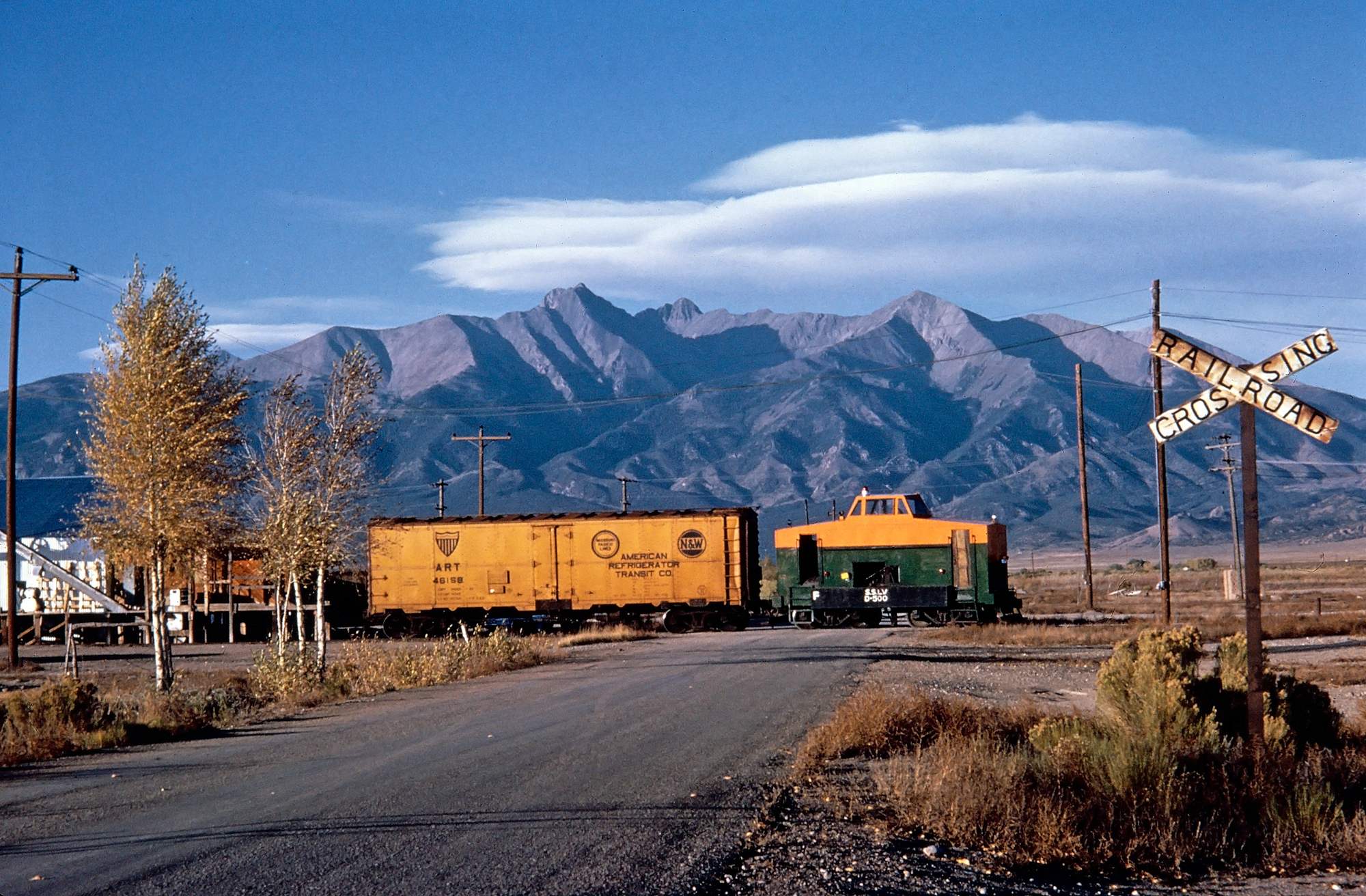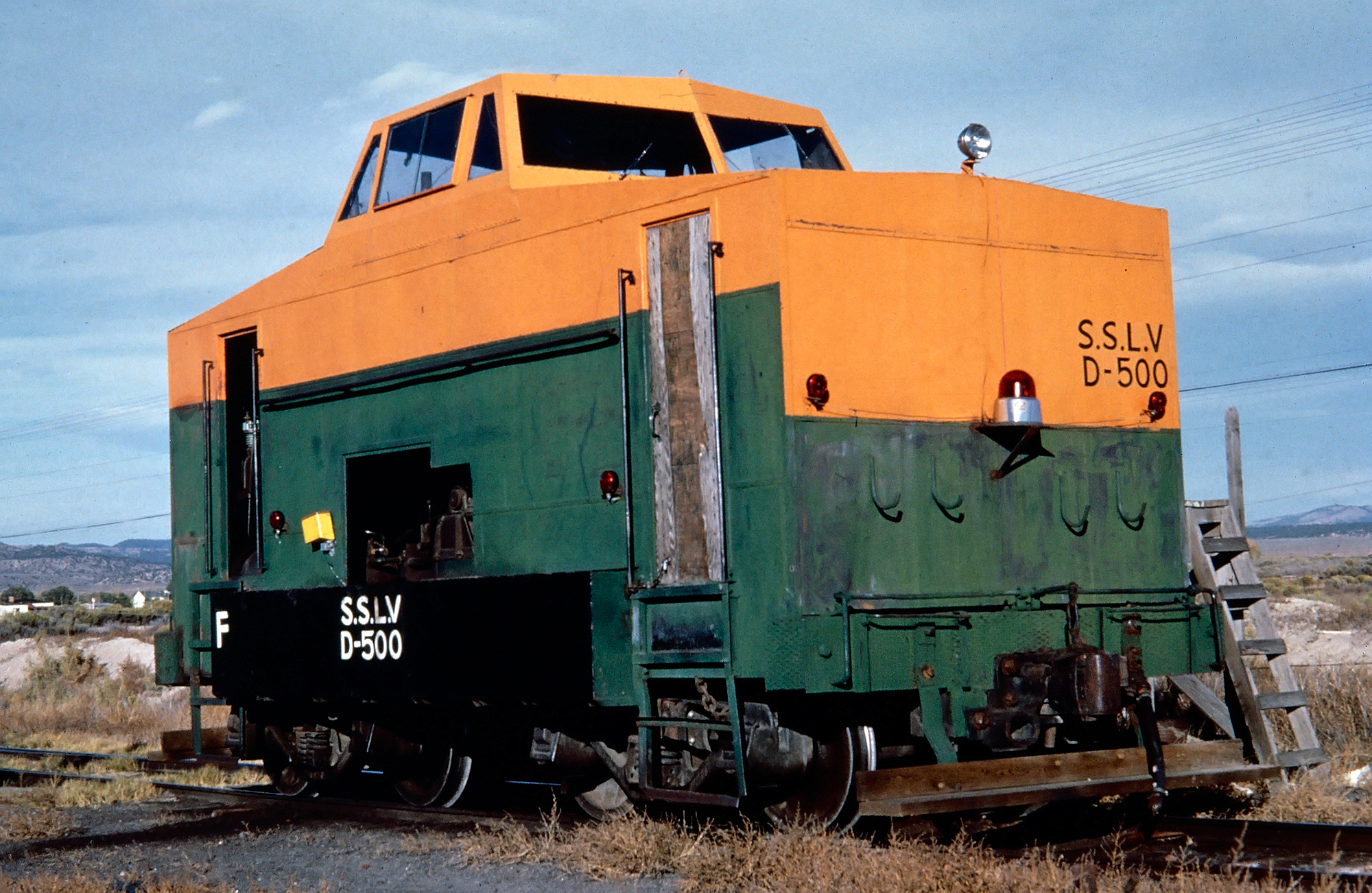Southern San Luis Valley Railroad: Route, Roster, History
Last revised: September 11, 2024
By: Adam Burns
The Southern San Luis Valley Railroad (SSLV) occupies an interesting niche in the rich tapestry of American railroad history.
This short line played a pivotal role in the development and sustenance of Colorado's San Luis Valley, demonstrating the profound impact of localized rail services on regional growth and economic development.
At its peak the SSLV operated 31 miles between a connection with the Rio Grande at Blanca to Jaroso, Colorado. However, the railroad is best remembered for its late era operations where it operated just 1.5 miles of track near Blanca and utilized a custom-built diesel switcher (pictured).
Photos
 Southern San Luis Valley's homebuilt diesel critter, D-500, in service at the Rio Grande connection in Blanca, Colorado during the fall of 1973. American-Rails.com collection.
Southern San Luis Valley's homebuilt diesel critter, D-500, in service at the Rio Grande connection in Blanca, Colorado during the fall of 1973. American-Rails.com collection.History
The history of the Southern San Luis Valley begins in the late 19th century, a time when the expansion of the railroad network across the United States was driving economic growth and facilitating the settlement of remote areas.
The San Luis Valley, with its fertile land and potential for agricultural development, attracted attention from investors and settlers alike. However, the valley's geographic isolation posed significant challenges, which the SSLV was established to address.
The system began as the San Luis Southern Railroad, chartered on July 3, 1909, under the auspices of the Costilla Estates Development Company.
This venture aimed to foster agricultural communities through the development of farmland. Envisioned as the lifeline for these small hamlets, the railroad's success hinged on the prosperity of the Costilla Estates, which in turn depended critically on irrigation from its constructed reservoirs.
The original line ran from a connection with the Denver & Rio Grande Western at Blanca, south to rural Jaroso at the New Mexico border. This route was strategic, serving not only the agricultural communities but also tapping into the rich mineral resources found in the surrounding mountains.
Predominantely, however, the railroad relied upon agricultural products such as barley and potatoes - and later, lettuce - from the valley to major markets across the United States.
Alas, nature had other plans for the fledgling railroad. The anticipated rainfall needed to fill these reservoirs proved insufficient, leading to unmet agricultural needs. The ripple effect was a lack of economic viability for both the estates and the railroad, propelling the latter into bankruptcy.
It was on this backdrop that Charles Boettcher, a prominent industrial magnate, stepped in. On January 6, 1928, Boettcher purchased the failing railroad, reinventing it later that year as the San Luis Valley Southern Railway.
Despite this new leadership and reorganization, the railroad continued to face formidable challenges. Under Boettcher's direction, while there were efforts to rejuvenate its operations, the railway struggled to find its stride in the shadow of persistent financial and environmental hurdles.
Official Guide Listing (3/1957)
 The Southern San Luis Valley's listing in the "Official Guide" just prior to much of the system being sold and abandoned. American-Rails.com collection.
The Southern San Luis Valley's listing in the "Official Guide" just prior to much of the system being sold and abandoned. American-Rails.com collection.There were a number of attempts to abandon the property after World War II. The first occurred on January 24, 1949 when the Boettcher/McLean estates petitioned the Interstate Commerce Commission (ICC) to discontinue operations.
This move sparked considerable resistance from local stakeholders in the valley, who saw value and potential in the railway's continued operation.
Amid these intense legal battles, two local businessmen entered into negotiations to acquire the property. Their timely acquisition occurred just two weeks before the scheduled abandonment hearings, marking a pivotal turn in the railroad's history.
From 1949 to 1954, the new owners navigated through a complicated landscape of financial arrangements and strategic maneuvers in an effort to sustain the struggling railway.
Despite their efforts, by September 19, 1952, owner W.W. McClintock found compelled to file for abandonment himself due to sagging traffic. However, the ICC only approved a partial abandonment on September 24, 1953, allowing McClintock to continue operations under constrained conditions.
In a continued effort to revive the company's fortunes, McClintock, along with George Oringdulf, another local businessman, embarked on a comprehensive reorganization.
They consolidated control by acquiring all outstanding stock and effectively tying up any loose ends. This restructuring culminated in the formation of a new entity under the laws of Colorado.
On December 11, 1953, this new venture was officially organized, and on October 22, 1954, it was rebranded as the Southern San Luis Valley Railroad (SSLV).
Motive Power
Over the decades, the railroad's roster has featured an eclectic mix of locomotives, each with its own story and pedigree. It began with #100 and #101, both Brooks 4-6-0s, former Lake Shore & Michigan Southern Railway. In addition, #102, a 2-6-0 built by Baldwin, was acquired new by the San Luis Southern.
The roster also included a quarter of former Rio Grande 2-8-0s (C-28): #103 (D&RGW 657), #104 (D&RGW 633), #105 (D#RGW 688), and #106 (D&RGW 683).
The railroad also operated a motorcar for passenger service, numbered M-3, built by Winter-Weiss in 1924. It was later renumbered M300 and is preserved but in a state of disrepair at the Oklahoma Railway Museum in Oklahoma City.
The most interesting locomotive, however, was a custom-built diesel critter. In the mid-20th century, McClintock and Oringdulph of grappled with a significant challenge.
Their two steam locomotives, #105 and #106, proved excessively costly to maintain. To reduce operating costs, they acquired the tender from Rio Grande 2-8-0 964 in 1950 and embarked on an ambitious project to fashion a more economical locomotive.
The initial attempt to build on the tender frame did not yield success. However, undeterred, by 1955, their persistence paid off with the completion of a distinctive machine, dubbed the D-500.
This unconventional locomotive was mounted on standard tender trucks, driven by a sprocket and chain drive system. It was powered by a 1091 cubic inch, UD24 diesel engine from International Harvester.
The innovative power transmission involved a Caterpillar hydraulic transmission that drove an old Euclid truck axle. This, in turn, channelled power via sprockets and chains to the axles.
The D-500 boasted an unusual design, resembling more a caboose than a traditional locomotive. It featured a cupola-styled cab, optimizing visibility and facilitating the installation of the primary engine components. The entire assembly was expertly crafted by the SSLV mechanics in Mesita, Colorado.
This inventive project culminated in a significant operational shift for the railroad. By 1957, all steam locomotives had been phased out on the SSLV, marking the end of an era and the beginning of a new chapter in railway ingenuity.
Final Years
Post-war, the SSLV continued to be a lifeline for the San Luis Valley, but like many railroads, it began to face challenges in the 1950s and 1960s from the rise of automobile travel and the construction of interstate highways.
These developments made truck transport increasingly viable and economical, eroding the market share of railroads.
By the late 1950s, the operating scope of the SSLV had significantly contracted. The railroad primarily functioned in a localized area, with its traffic base concentrated near Blanca with minimal south of that point.
On March 15, 1958, the railroad discontinued operations on the southerly 29 miles from McClintock to Jaroso; the tracks were subsequently sold to the Climax Molybdenum Company. This left the SSLV operating a mere 2.5-mile section southward from Blanca.
This truncated segment enabled the SSLV to serve strategic local industries; notably, it facilitated operations for the Colorado Aggregates Company at McClintock and the Mizokami lettuce packing plant, located just north of the McClintock wye.
Alas, the closure of the Mizokami lettuce plant in the late 1970s marked the end of an era. The following sale of the SSLV to the Hecla Mining Company signaled another significant transformation, illustrating the evolving economic landscape in which these rail operations were embedded.
 Southern San Luis Valley's homebuilt diesel critter, D-500, at the Rio Grande connection in Blanca, Colorado during the summer of 1973. The locomotive was built from a steam tender frame and utilized an I-H (International Harvester) power plant. American-Rails.com collection.
Southern San Luis Valley's homebuilt diesel critter, D-500, at the Rio Grande connection in Blanca, Colorado during the summer of 1973. The locomotive was built from a steam tender frame and utilized an I-H (International Harvester) power plant. American-Rails.com collection.Legacy
Today, the legacy of the Southern San Luis Valley Railroad is evident in the continued importance of rail transport in the region. Although no longer operating under its original name, the tracks of the SSLV continue to support local industries and remain a critical part of the infrastructure supporting the San Luis Valley’s economy.
In conclusion, the history of the Southern San Luis Valley Railroad is a compelling chapter in the story of American railroads. It highlights the crucial role of small-scale, community-focused rail services in supporting regional economies.
The SSLV may not have the name recognition of larger railroads, but its impact on the communities it served is a testament to the broader significance of railroads in American economic and regional development.
This history serves not only as a record of past achievements but also as a reminder of the potential for specialized transportation solutions to drive economic success in geographically isolated areas.
Of note, former 2-8-0 #106 has been restored to its original D&RGW number and markings, and is proudly displayed at the Colorado Railroad Museum in Golden.
Recent Articles
-
New Mexico Railroad Museums: A Complete Guide
Apr 23, 25 02:25 PM
The enchanting state of New Mexico, known for its vivid landscapes and rich cultural heritage, is home to a number of fascinating railroad museums. -
New Hampshire Railroad Museums: A Complete Guide
Apr 23, 25 02:11 PM
New Hampshire, known for its breathtaking landscapes, historic towns, and vibrant culture, also boasts a rich railroad history that has been meticulously preserved and celebrated across various museum… -
Minnesota Railroad Museums: A Complete Guide
Apr 22, 25 12:17 PM
The state of Minnesota has always played an important role with the railroad industry, from major cities to agriculture. Today, several museums can be found throughout the state.